Harvest Weed Seed Control: Seed Production and Retention of Fallopia convolvulus, Sinapis arvensis, Spergula arvensis and Stellaria media at Spring Oat Maturity
Abstract
1. Introduction
2. Materials and Methods
3. Results
3.1. Seed Production and Shedding in 2018
3.2. Seed Production and Shedding in 2019
3.3. Plant Dry Weight
4. Discussion
Author Contributions
Funding
Conflicts of Interest
References
- Andreasen, C.; Stryhn, H. Increasing weed flora in Danish arable fields and its importance for biodiversity. Weed Res. 2008, 48, 1–9. [Google Scholar] [CrossRef]
- Holm, L.G.; Plucknett, D.L.; Pancho, J.V.; Herberger, J.P. The World’s Worst Weeds—Distribution and Biology; The University Press of Hawaii: City of Honolulu, HI, USA, 1997; p. 609. [Google Scholar]
- Hume, L.; Martines, J.; Best, K. The biology of Canadian weeds. 60. Polygonum convolvulus L. Can. J. Plant Sci. 1983, 63, 959–971. [Google Scholar] [CrossRef]
- Thut, H.F.; Loomis, W.E. Relation of light to growth of plants. Plant Physiol. 1944, 19, 117–130. [Google Scholar] [CrossRef] [PubMed]
- Warwick, S.I.; Beckie, H.J.; Thomas, A.G.; McDonald, T. The biology of Canadian weeds. 8. Sinapis arvensis L. (updated). Can. J. Plant Sci. 2000, 80, 939–961. [Google Scholar] [CrossRef]
- Fogg, G. Biological flora of British Isles: Sinapis arvensis L. J. Ecol. 1950, 38, 415–429. [Google Scholar] [CrossRef]
- Mulligan, G.; Bailey, L. The biology of Canadian weeds: 8. Sinapis arvensis L. Can. J. Plant Sci. 1975, 55, 171–183. [Google Scholar] [CrossRef]
- Edwards, M. Aspects of population ecology of charlock. J. Appl. Ecol. 1980, 17, 151–171. [Google Scholar] [CrossRef]
- Long, H.C. Weeds of Arable Land; MAFF Bulletin No. 108; HMSO: London, UK, 1938; p. 215. [Google Scholar]
- Salisbury, E.J. Weeds and Aliens; Collins: London, UK, 1964; p. 384. [Google Scholar]
- Turkington, R.; Kenkel, N.C.; Franko, G.D. The biology of Canadian weeds. 42. Stellaria media (L.) Vill. Can. J. Plant Sci. 1980, 60, 981–992. [Google Scholar] [CrossRef]
- Naber, H.; Luften, W. Chickweed in grassland and its control. Bedrijfsonwikkeling 1972, 3, 911–913. [Google Scholar]
- Lawson, H.M. Weed competition in transplanted spring cabbage. Weed Res. 1972, 12, 254–264. [Google Scholar] [CrossRef]
- Korsmo, E.; Vidme, T.; Fykse, H. Korsmos Ugras Plansjer; Landbruksforlaget a. s.: Oslo, Norway, 1981; p. 295. [Google Scholar]
- Shivrain, V.K.; Burgos, N.R.; Agrama, H.A.; Lawton-Raug, H.; Lu, B.; Sales, M.A.; Boyett, V.; Gealy, D.R.; Moldenhauer, K.A.K. Genetic diversity of weedy red rice (Oryza Sativa) in Arkansas, USA. Weed Res. 2010, 50, 289–302. [Google Scholar] [CrossRef]
- Norsworthy, J.K.; Ward, S.M.; Shaw, D.R.; Llewellyn, R.S.; Nichols, R.L.; Webster, T.M.; Bradley, K.W.; Frisvold, G.; Powles, S.B.; Burgos, N.R.; et al. Reducing the risks of herbicide resistance: Best management practices and recommendations. Weed Sci. 2012, 60, 31–63. [Google Scholar] [CrossRef]
- Bagavathiannan, M.V.; Norsworthy, J.K. Late-season seed production in arable weed communities: Management implications. Weed Sci. 2012, 60, 325–334. [Google Scholar] [CrossRef]
- Walsh, M.J. Effectiveness of seed collection systems collecting ryegrass seed. In Proceedings of the 8th Australian Agronomy Conference, University of Southern Queensland, Toowoomba, Australia, 30 January–2 February 1996. [Google Scholar]
- Walsh, M.; Newman, P.; Powles, S. Targeting weed seeds in-crop: A review weed control paradigm for global Agriculture. Weed Technol. 2013, 27, 431–436. [Google Scholar] [CrossRef]
- Walsh, M.; Ouzman, J.; Newman, P.; Powles, S.; Liewellyn, R. High levels of adoption indicate that harvest weed seed control is now an established weed control practice in Australian cropping. Weed Technol. 2017, 31, 341–347. [Google Scholar] [CrossRef]
- Walsh, M.J.; Broster, J.C.; Schwartz-Lazaro, L.M.; Norsworthy, J.K.; Davis, A.S.; Tidemann, B.D.; Beckie, H.J.; Lyon, D.J.; Soni, N.; Neve, P.; et al. Opportunities and challenges for harvest weed seed control in global cropping systems. Pest Manag. Sci. 2018, 74, 2235–2245. [Google Scholar] [CrossRef] [PubMed]
- Shirtliffe, S.J.; Entz, M.H.; Van Acker, R.C. Avena fatua development and seed shatter as related to thermal time. Weed Sci. 2000, 48, 555–560. [Google Scholar] [CrossRef]
- Walsh, M.; Powles, S. High seed retention at maturity of annual weeds infesting crop fields highlights the potential for harvest weed seed control. Weed Technol. 2014, 28, 486–493. [Google Scholar] [CrossRef]
- Walsh, M.J.; Broster, J.C.; Aves, C.; Powles, S.B. Influence of annual ryegrass seed retention height on harvest weed seed control (HWSC) and harvest efficiency. In Proceedings of the 20th Australian Weeds Conference, Council of Australasian Weed Societies, Perth, Australia, 11–15 September 2016; pp. 42–45. [Google Scholar]
- R Development Core Team. R: A Language and Environment for Statistical Computing (Vienna: R Foundation for Statistical Computing) 2017. Available online: http:/www.R.-project.org (accessed on 5 December 2019).
- Bates, D.; Maechler, M.; Bolker, B.; Walker, S. Fitting Linear Mixed-Effects Models Using lme4. J. Stat. Softw. 2015, 67, 1–48. [Google Scholar] [CrossRef]
- Hothorn, T.; Bretz, B.; Westfall, P. Simultaneous inference in general parametric models. Biom. J. 2008, 50, 346–363. [Google Scholar] [CrossRef]
- Danish Metrological Institute (DMI): Vejr, klima og hav. Available online: https://www.dmi.dk/vejr/arkiver/maanedsaesonaar/ (accessed on 1 September 2019).
- Wright, K.J.; Seavers, G.P.; Peters, N.C.B.; Marshall, M.A. Influence of soil moisture on the competitive ability and seed dormancy of Sinapis arvensis in spring wheat. Weed Res. 1999, 39, 309–317. [Google Scholar] [CrossRef]
- Forcella, F.; Peterson, D.H.; Barbour, J.C. Timing and measurement of weed seeds shed in corn (Zea mays). Weed Technol. 1996, 10, 535–543. [Google Scholar] [CrossRef]
- Burton, N.R.; Beckie, H.J.; Willenborg, C.J.; Shirtliffe, S.J.; Schoenau, J.J.; Johnson, E.N. Seed shatter of six economically important weed species in producer fields in Saskatchewan. Can. J. Plant Sci. 2017, 97, 266–276. [Google Scholar] [CrossRef]
- Dosland, J.; Arnold, J. Leaf area development and dry matter production of wheat and wild buckwheat growing in competition. In Abstracts of the Meeting of Weed Society of America; Department of Agronomy, University of Illinois: Urbana, IL, USA, 1966; p. 56. [Google Scholar]
- Tidemann, B.D.; Hall, L.M.; Harker, K.N.; Beckie, H.J.; Johnson, E.N.; Stevenson, F.C. Sustainability of wild oat (Avena fatua), false cleavers (Galium spurium), and volunteer canola (Brassica napus) for harvest weed seed control in Western Canada. Weed Sci. 2017, 65, 769–777. [Google Scholar] [CrossRef]
- Beam, S.C.; Mirsky, S.; Cahoon, C.; Haak, D.; Flessner, M. Harvest weed seed control of Italian ryegrass (Lolium perenne L. ssp. multiflorum (Lam.) Husnot), common ragweed (Ambrosia artemisiifolia L.), and Palmer amaranth (Amaranthus palmeri S. Watson). Weed Technol. 2019, 33, 627–632. [Google Scholar] [CrossRef]
- Goplen, J.J.; Sheaffer, C.C.; Becker, R.L.; Coulter, J.A.; Breitenbach, F.R.; Behnken, L.M.; Johnson, G.A.; Gunsolus, J.L. Giant ragweed (Ambrosia trifida) seed production and retention in soybean and field margins. Weed Technol. 2016, 30, 246–253. [Google Scholar] [CrossRef]
- Schwartz-Lazaro, L.M.; Green, J.K.; Norsworthy, J.K. Seed retention of palmer amaranth (Amaranthus palmeri) and barnyardgrass (Echinochola crus-galli) in soybean. Weed Technol. 2017, 31, 617–622. [Google Scholar] [CrossRef]
- Schwartz, L.M.; Norsworthy, J.K.; Young, B.G.; Bradley, K.W.; Kruger, G.R.; Davis, V.M.; Steckel, L.E.; Walsh, M.J. Tall waterhemp (Amaranthus tuberculatus) and palmer amaranth (Amaranthus palmeri) seed production and retention at soybean maturity. Weed Technol. 2016, 30, 284–290. [Google Scholar] [CrossRef]
- Harrison, S.K. Interference and seed production by common lambsquarters (Chenopodium album) in soybeans (Glycine max). Weed Sci. 1990, 49, 224–229. [Google Scholar] [CrossRef]
- Norris, R.F. Weed fecundity: Current status and future needs. Crop. Prot. 2007, 26, 182–188. [Google Scholar] [CrossRef]
- Steckel, L.E.; Sprague, C.L. Late-season common waterhemp (Amaranthus rudis) interference in narrow- and wide-row soybean. Weed Technol. 2004, 18, 947–952. [Google Scholar] [CrossRef]
- Webster, T.M.; Grey, T.L. Glyphosate-resistant palmer amaranth (Amaranthus palmeri) morphology, growth, and seed production in Georgia. Weed Sci. 2015, 63, 264–282. [Google Scholar] [CrossRef]
- Zimdahl, R.L. Weed-Crop Competition, 2nd ed.; Blackwell Publishing: Oxford, UK, 2004; p. 220. [Google Scholar]
- Jakobsen, K.; Jensen, J.A.; Bitarafan, Z.; Andreasen, C. Killing weed seeds with exhaust gas from a combine harvester. Agronomy 2019, 9, 544. [Google Scholar] [CrossRef]
- Andreasen, C.; Bitarafan, Z.; Fenselau, J.; Glasner, C. Exploiting waste heat from combine harvesters to damage harvested weed seeds and reduce weed Infestation. Agriculture 2018, 8, 42. [Google Scholar] [CrossRef]
- Glasner, C.; Vieregge, C.; Robert, J.; Fenselau, J.; Bitarafan, Z.; Andreasen, C. Evaluation of new harvesting methods to reduce weeds in arable fields and collect a new feedstock. Energies 2019, 12, 1688. [Google Scholar] [CrossRef]
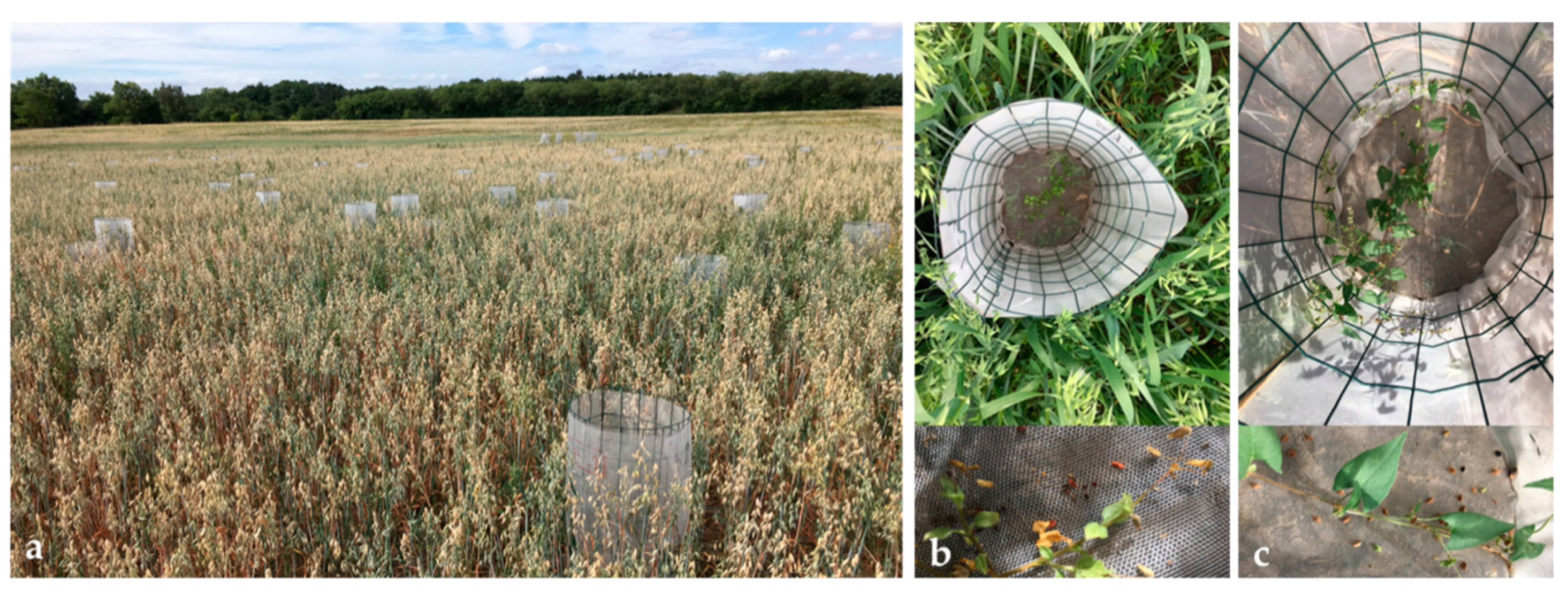

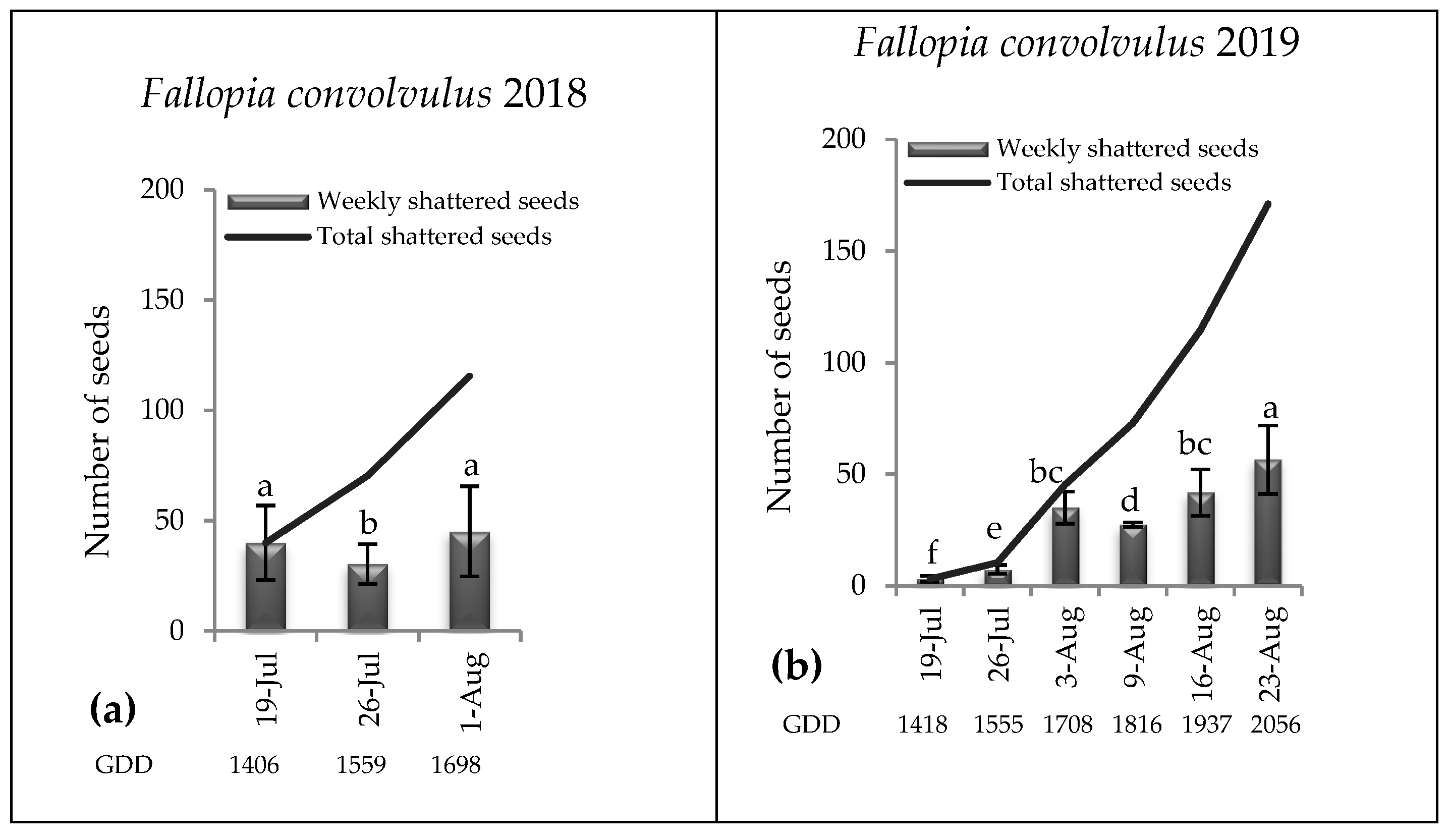
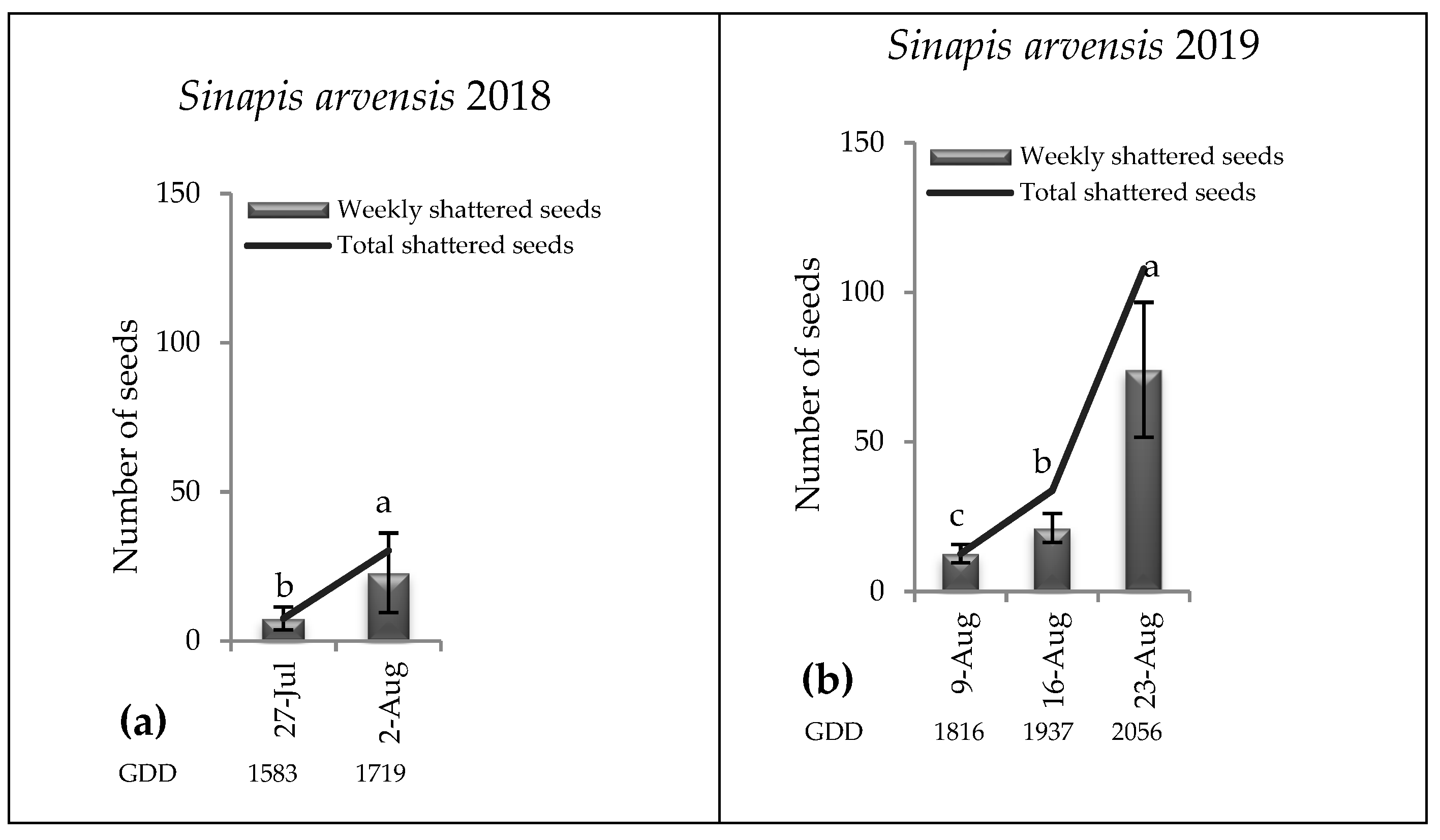
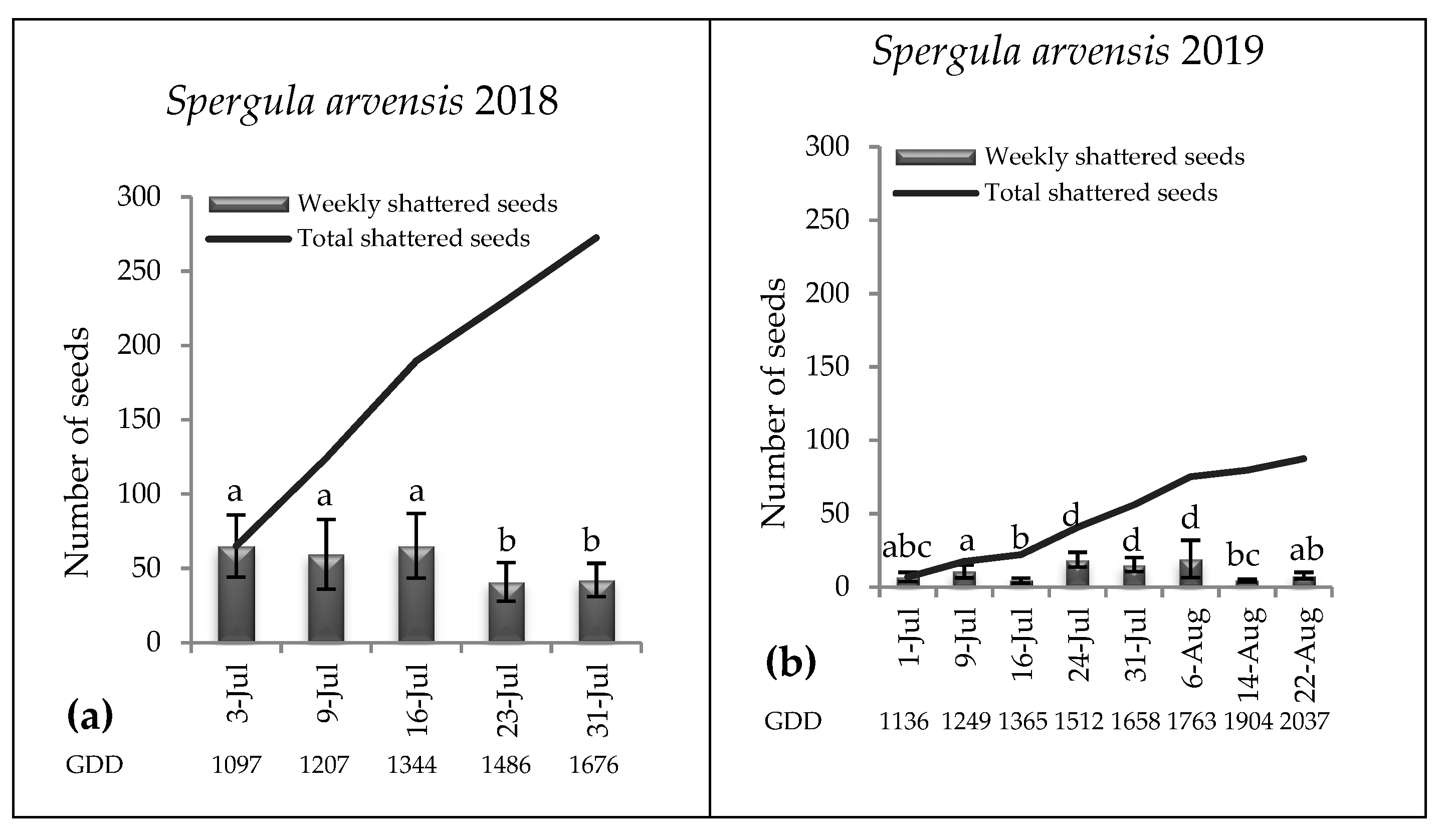
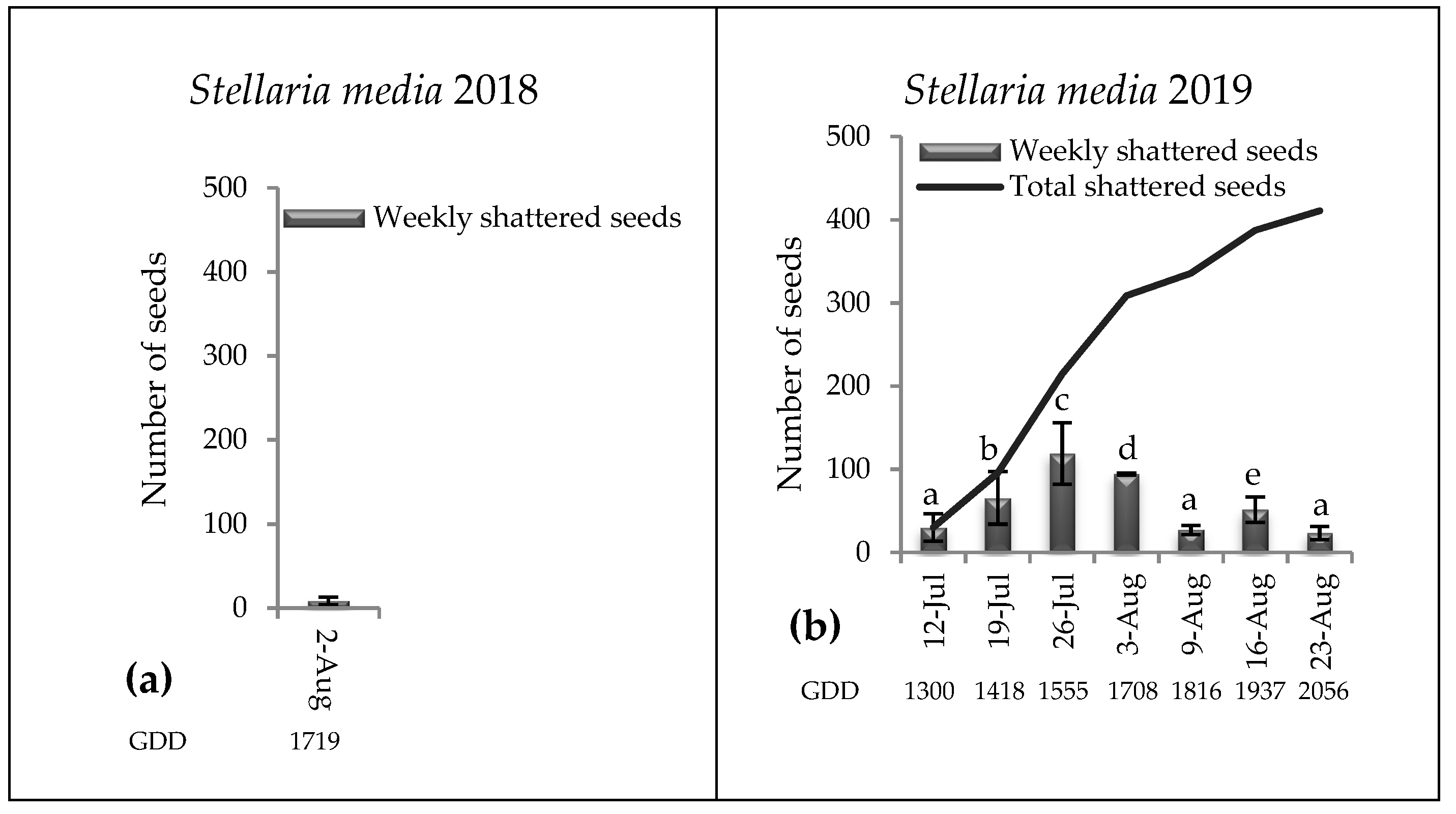
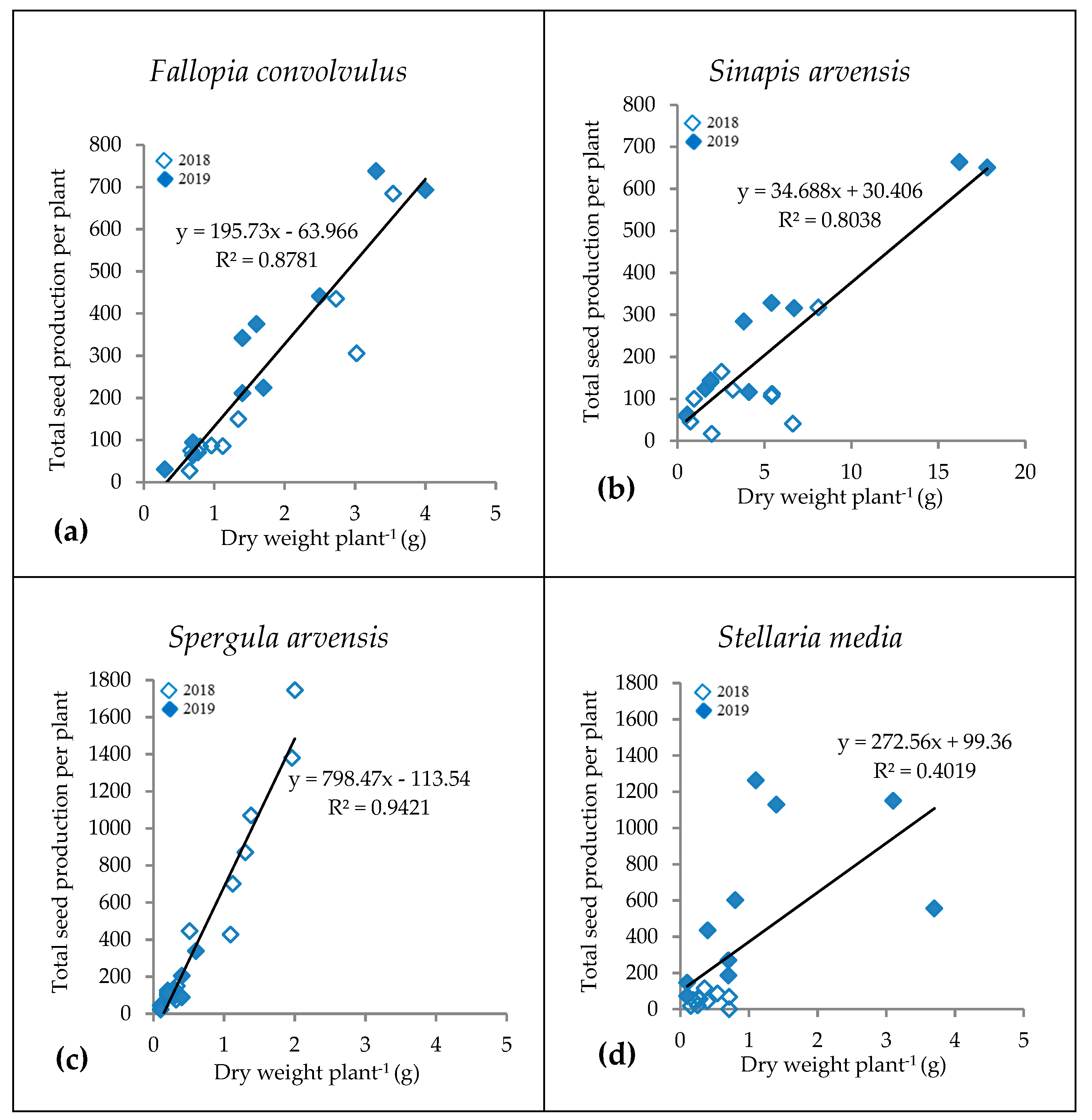
© 2019 by the authors. Licensee MDPI, Basel, Switzerland. This article is an open access article distributed under the terms and conditions of the Creative Commons Attribution (CC BY) license (http://creativecommons.org/licenses/by/4.0/).
Share and Cite
Bitarafan, Z.; Andreasen, C. Harvest Weed Seed Control: Seed Production and Retention of Fallopia convolvulus, Sinapis arvensis, Spergula arvensis and Stellaria media at Spring Oat Maturity. Agronomy 2020, 10, 46. https://doi.org/10.3390/agronomy10010046
Bitarafan Z, Andreasen C. Harvest Weed Seed Control: Seed Production and Retention of Fallopia convolvulus, Sinapis arvensis, Spergula arvensis and Stellaria media at Spring Oat Maturity. Agronomy. 2020; 10(1):46. https://doi.org/10.3390/agronomy10010046
Chicago/Turabian StyleBitarafan, Zahra, and Christian Andreasen. 2020. "Harvest Weed Seed Control: Seed Production and Retention of Fallopia convolvulus, Sinapis arvensis, Spergula arvensis and Stellaria media at Spring Oat Maturity" Agronomy 10, no. 1: 46. https://doi.org/10.3390/agronomy10010046
APA StyleBitarafan, Z., & Andreasen, C. (2020). Harvest Weed Seed Control: Seed Production and Retention of Fallopia convolvulus, Sinapis arvensis, Spergula arvensis and Stellaria media at Spring Oat Maturity. Agronomy, 10(1), 46. https://doi.org/10.3390/agronomy10010046




